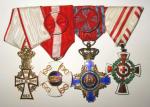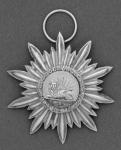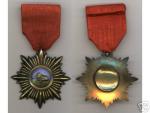-
Posts
1,232 -
Joined
-
Last visited
-
Days Won
9
Content Type
Profiles
Forums
Blogs
Gallery
Events
Store
Everything posted by Great Dane
-
The following story may - at first look - seem to be aimed specifically at my field of interest, but I hope it will serve as an inspiration for others as well. The problem is quite 'universal' 1. The problem: The problem is trying to find the recipient of an unnamed medal group (or miniature group). In my case I collect Danish decorations. My sources are some unofficial volumes which were infrequently published (7 volumes between 1903 and 1970) and which contains lists of people decorated with the Danish Order of Dannebrog (as per the year they were published). Each volume contains thousands of small biographies (basically name, list of decorations and 10-15 lines bio). The limitation of using these volumes as sources is of course that the recipient of a medal group had to be decorated with the Order of Dannebrog - otherwise he won't be in there. So far a match were attempted by meticulously comparing the list of decorations in each bio with the medal group in question. Very very tedious work...! There were tens of thousands biographies to check, and the next time an unnamed group showed up, I had to start all over again. There simply had to be an easier way... My goal was to be able to input a list of decorations (those present in the medal group) into a PC and get a list of possible recipients as output. I could then lookup the candidates in the printed volumes to get more information. 2. First approach: First I considered to scan each page and OCR it to get a searchable result. It would be quite a time consuming task, but it had to be done only once. However, this solution had some disadvantages: Scanning 100 year old books without damaging them could be difficult.The scans might need a 'touch-up' before they were fed to the OCR engine. That would be even more time consuming.A search is an 'exact science'. If I searched for, say, 'S.Sv.' (the abbreviation used for the Swedish Order of the Sword), I wouldn't catch the typos 'SSv.' (missing point) or 'S. Sv.' (added space).I would only be able to search for one string at a time. A search for 'S.Sv.' would give thousands of hits, which had to be examined one by one to check if that recipient had received the other decorations in the group as well. Hmm... the benefits of this approach really didn't seem to justify the trouble... 3. The solution: I decided to use a spreadsheet (Excel) for the task. Each row would contain a name and a list of his decorations (one cell for each decoration). This information had to be entered manually (still a time consuming task but again had to be done only once). I decided to leave out the class information from the list of decorations, because I assumed there would be cases where I couldn't identify the class of a given decoration in a group. No need to limit myself there... 3.1 Digitizing the sources: Using Excel had some advantages - the AutoComplete functionality was nice and I wrote a macro which - after entering a complete volume - could compare my entries to a list of 'approved' decoration abbreviations. That way I would catch typos made in the data entry phase. I considered to use a database, but although the 'search & compare' task will save me a lot of time it isn't very complicated. A database would be overkill. 3.2 Extracting the data: I wrote two macros - a 'search by name' and a 'search by decorations'. This gives me the following possibilities: Searching by name is useful if I want to research a named award document. Enter the name, press the button, and I will have a chronological list of which volumes that guy is listed in.I can search for ANY combination of decorations - even subsets (useful if the recipient's list of decorations includes Commander and Grand Cross classes which will not be present in the mounted group or if he received a decoration after the volume was published). There is no restrictions in which order I enter the decorations to be searched for.4. An example: My tool has proven to be extremely useful for me over the last couple of years. This is the latest example: I bought a mounted group of 4. The decorations were mounted 'Danish style' and the first decoration was the Order of Dannebrog, so the primary condition was fulfilled (I have attached a (not very good) picture of the group below to spice up my long ranting). The group came in a flat unoriginal cardboard box padded with cotton wool. The other decorations were the Italian Order of the Crown, the Romanian Order of the Star and the Austrian Red Cross decoration. I entered the four decorations in my tool, pressed the button and the result was one match (the result also showed that noone had the four decorations as a subset and the guy with the match was not listed with additional decorations in later volumes). I looked him up in the printed volume and the classes of the decorations matched the group 100%. Normally the story would end here but this example had an extra twist: I felt pretty confident that I had found the correct recipient and was about to throw away the cardboard box, when suddenly I discovered a small stamp-size note under the cotton wool. On it was written the very same name that I just found I realize this post seems like I'm padding my own back, but this tool has removed a lot of the tedious part of medal research for me. I realize that 'your mileage may vary' (different sources, different conditions, different problems etc.) but I just felt it could inspire others to try something similar. /Mike
-

Persian Order of the Lion and Sun
Great Dane replied to Great Dane's topic in Middle East & Arab States
Hmm... so even here there is an inconsistency between Buyers nine-pointed star (1. class) and Morton & Eden's ten-pointed star... However, if Jeff's source is sure about the ribbon descriptions, then that's the best lead I've had so far... /Mike -

Persian Order of the Lion and Sun
Great Dane replied to Great Dane's topic in Middle East & Arab States
Jeff, Is this Order of Science similar to the one I had doubts about in posting #7 (Nishan-i-Ilmi)? I have only seen that one with a ten-pointed star. /Mike -

Persian Order of the Lion and Sun
Great Dane replied to Great Dane's topic in Middle East & Arab States
Excellent news, Jeff Finally some light at the end of the tunnel Now I have a starting point for further investigation. /Mike -

Persian Order of the Lion and Sun
Great Dane replied to Great Dane's topic in Middle East & Arab States
Thanks for the links, Ed. I've been there already, without getting any wiser unfortunately... Maybe I should start taking Farsi classes just to solve this mystery /Mike -
I have a couple of comments Timeframe: The Thai Order of the Crown is the post-1946 design (as far as I can tell). The Black Star of Benin is obviously pre-1963. So the timeframe for the group is quite wide - at least a period from 1918 to 1946. Recipient: I don't know about the diplomat theory - wouldn't a diplomat have many more orders? Of course a diplomat could have received a lot of Commander's Crosses and Grand Crosses, but then we're back to just guessing. I have a group belonging to a department manager and member of the board of 'Alliance Francaise'. He received the Black Star of Benin order (Commander) but wasn't connected to the diplomatic service at all. Actually the recipients of the Black Star of Benin and the Thai Order of the Crown were all kinds of people (that is, the kind of people who would normally be eligible for a national knight cross...). /Mike
-

Persian Order of the Lion and Sun
Great Dane replied to Great Dane's topic in Middle East & Arab States
My goodness, what an ugly specimen I can understand nations that doesn't have the financial means or the resources to make 'jeweller beauties', but this was made in Sweden by Sporrong?! Are you sure it isn't a theater piece??? /Mike -

Persian Order of the Lion and Sun
Great Dane replied to Great Dane's topic in Middle East & Arab States
Very nice document However, I'm still not sure if the order in question actually is the Order of the Lion and Sun (I'm more and more convinced that it isn't...) /Mike -

Rosenborg Slot (Copehnagen)
Great Dane replied to Ed_Haynes's topic in Northern European & Baltic States
Great pictures, Ed It was actually your mentioning of Rosenborg Castle in another thread that made me visit the castle earlier this year. Although I live in the same city, I'm ashamed to admit that it was my first visit Knowing my (lack of) photographic skills I didn't bring a camera... They definitely have a great collection. It will not be my last visit. The interesting thing about the orders and decorations in the castle is that they were not 'collected' for the purpose of a museum display. They are the actual decorations given to the various Danish kings. /Mike -
Good luck with it However it is my experience that even if a country has lists of recipients of a specific order, they rarely include foreigners. Too much work I guess, if the lists are compiled based on feedback from the recipients. You might be lucky with a request directly to the Chancellery though... /Mike
-
Yes, a civilian could certainly be awarded the Black Star of Benin. As Ed Haynes points out it rarely had anything to do with Benin, but was used as a sort of 'lesser degree' decoration, i.e. used to award those who did not qualify for, say, a Legion d'Honneur. In the big French 'clean up' in 1963 a lot of decorations were merged into the National Order of Merit. The Black Star of Benin was one of them. /Mike
-

Denmark Danish? Artillery field cap
Great Dane replied to Avitas's topic in Northern European & Baltic States
Pat, On another forum (I'm not sure if it's frowned upon to post a link here?) there is a cap exactly like yours with the same markings. The conclusion there is: "Spanish infantry enlisted, years 40-50s" /Mike -

Denmark Danish? Artillery field cap
Great Dane replied to Avitas's topic in Northern European & Baltic States
Hmm... none of this seems to be Danish. "Talla" is definitely not Danish unless it's some weird 'internal lingo' that I've never heard of... Sounds more like Italian or Spanish to me (but as I said - I don't really know much about uniforms)... If it turns out to Danish after all, then I'll stand corrected /Mike -

Denmark Danish? Artillery field cap
Great Dane replied to Avitas's topic in Northern European & Baltic States
I've never seen this type of cap before here (but I'm not an expert in uniforms). But I don't reckognize any Danish words either. Is it possible to get a better scan of the markings inside? Then I can quickly tell you if the words are Danish or not. /Mike -

Persian Order of the Lion and Sun
Great Dane replied to Great Dane's topic in Middle East & Arab States
The Swedish dealer's group is quite interesting, because I think some information can be deduced from it: - That recipient was awarded the Order of S&L twice (the two green ribbons) with and without the 'thingy' on top. And as the unknown order (red ribbon) is in the same group but in a quite different design, that could indicate that the unknown order is not the Order of S&L. - The two green-ribboned Orders of S&L are clearly pre-Pahlavi era (i.e. awarded before 1925) because they have the old design (in 1925 the design was 'modernized' and it was renamed Nishan-i-Homayoun), and this might indicate that the unknown order is also a pre-Pahlavi order. Rick, I also read somewhere that the standing lion holding a sword was for Muslims but Mulder writes that this only indicates a military award, while the lion lying down is the civilian version... /Mike -

Persian Order of the Lion and Sun
Great Dane replied to Great Dane's topic in Middle East & Arab States
BTW: Thanks for the kind words, Ed At one point I thought I finally had nailed it down. In Morton and Eden's auction catalog from 18. July 2006 (lot 136) this order (see picture below) is described as "Iran, Order of Arts and Science (Nishan-i-Ilmi), founded 1852, First class breast badge, third-quarter of the 19th century, of Iranian manufacture, in gold, with enamelled centre." Then I discovered the very same picture used in Morton and Eden's auction catalog from 25. May 2005 (lot 427), but then the text was "Qajar, Order of the Lion and Sun (Homayoun), Civil Division, mid-19th century, of Iranian manufacture, superior grade breast badge, in gold, the centre bearing a lion couchant and sun in gold and enamels, surrounded by a gold ten rayed badge." So Persian orders seems to be a mystery to the experts at Morton and Eden too However whatever that one is, I'm not sure mine is similar. Notice the ten-pointed star and the ornamented circle around the center disc. /Mike -

Persian Order of the Lion and Sun
Great Dane replied to Great Dane's topic in Middle East & Arab States
And another search on the internet brought up this picture (but again without any info whatsoever...): /Mike -

Persian Order of the Lion and Sun
Great Dane replied to Great Dane's topic in Middle East & Arab States
A little more about my research so far: First I thought that maybe the red ribbon was for the French Legion d'Honneur and somebody had swapped the badge, but then I saw this picture on the website of a Swedish dealer (see below). Unfortunately all he knew about that group was "A group of persian medals... /Mike -

Persian Order of the Lion and Sun
Great Dane replied to Great Dane's topic in Middle East & Arab States
Ed, your wish is my command... The only information the seller had about this group was that it had belonged to "a railway engineer working in Persia". From the two other orders I would date it to somewhere around the 1920s. Notice that the Lion and Sun is made separately (of metal) and fixed to the handpainted center disc. The order is gold colored, but I'm not sure it's gold. There are no markings on the back. Although Mulder mentions that at some point there was 89(!) different grades/classes of The Order of the Lion and Sun (and 6-8 different colors of the ribbons/sashes), I simply can't fit this one in... All the experts I have asked so far have given up. It's quite a mystery. /Mike -
Hello all, I'm trying to research a Persian Order - Order of the Lion and Sun - which is part of a mounted group in my collection. I've read C. P. Mulders booklet "Persian Orders 1808-1925", but I'm still a bit in the dark. In the literature list there is a reference to an article in 'The Medal Collector Sept./Oct. 1957' by Klietmann titled "History of the Lion and Sun Order of Persia". Does any of you have access to this article? P.S: When I claim to be in the dark it's actually quite an understatement - I'm not even sure the Order in question is The Order of the Lion and Sun... Thanks in advance, /Mike
-
Thanks for all the suggestions. Someone once recommended using WD-40, but since that treatment also involved "and then you just polish it until it is nice and shiny" I didn't want to go down that road... Sounds like the softened toothpick is worth a try. Maybe the 'secret' is to remove ALL of it, so that it doesn't grow back...? I'll give it a go... Thanks gentlemen, /Mike
-
Hello gentlemen, I have a US Bronze Star (part of a mounted group) which has two small patches of that blue-green stuff that often is seen on copper (verdigris?). What is the best method to get rid of it (I'm afraid of leaving it there, as it might 'grow')? What causes it? I tried to remove some of it with just a soft cloth. It got a little better but after a few weeks it was the same as before (and I don't live in a particular moist climate). So before I move on to more drastic methods, I thought I'd better ask the experts. Thanks in advance, /Mike






